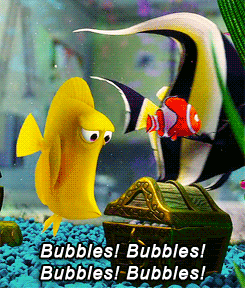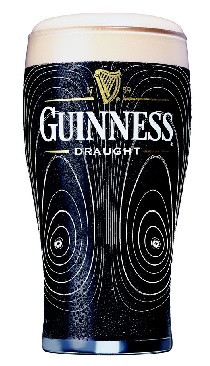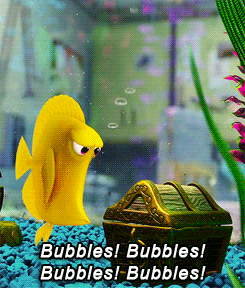Let’s talk bubbles…

Over the summer, I have tapped quite a few beers. Some of those beers were Guinness. The first few times I went through the Guinness-tapping-process (who am I kidding, all the times), I would marvel at the fact that the bubbles were going down.
So, Guinness is an easy but slightly time-consuming beer to tap. First, you need to fill the glass about 4/5ths and let the bubbles settle. When you get that nice black/white beer/foam divide, you top it off by pushing on the tap (which is a slower flow). So that all takes a while. But that means you can stare at these sinking bubbles for quite some time.

But wait. Bubbles aren’t supposed to sink? Aren’t bubbles gaseous and therefore lighter than liquid? Hence, shouldn’t they rise as bubbles do in normal bubbly beverages? What’s going on?
From a uni class some time ago, I remembered that Guinness bubbles sink, so at least I wasn’t hallucinating. But why I forgot why exactly. (Com’on, the class was years ago and who remembers anything anyway. There’s the internet for that.)
Of course, there is science about this. I mean. Scientists are basically fueled by coffee and beer. And Guinness is sort of both.
It seems that there are a few factors that contribute to the sinking bubbles: the type of bubbles, the size of the bubbles, and the shape of a Guinness glass.
First of all, not all bubbles in Guinness sink, just the ones you can see. When the beer starts to settle, larger bubbles start to rise (as bubbles do). Because of the shape of the glass, you can’t really see this happening: the bubbles originate in the bottom of the glass, which is narrower than the top, and they form a central column of rising bubbles. This causes an upward liquid movement. As a result (because the liquid doesn’t magiacally fountain out of the glass), a downwards liquid flow occurs along the walls of the glass. If all the Guinness bubbles were large (> 50 µm), as is the case with bubbles in lighter beers, the buyancy would counteract the liquid flow (they’d be superlight and not care about what the liquid is doing) and rise. However, Guinness has teeny tiny bubbles (< 50 µm) that just get dragged along with the flow. And therefore, along the walls of the glass, they appear to be sinking.

So the second factor is the small bubbles. Guinness taps have fine holes that cause these small bubbles to form*. Moreover, Guinness bubbles are nitrogen and not carbon dioxide, which is more easily dissolvable in liquid. Most bubbly beverages, including lager beers and soft drinks, contain carbon dioxide to create the fizz. In these cases, gas bubbles appear from tiny defects in the glass surface and continue to grow as more carbon dioxide undissolves**. But nitrogen gas doesn’t dissolve in liquid as well as carbon dioxide, so the bubbles that do appear don’t grow in size. In other words, bubbles stay small enough to be dragged along with the downward liquid flow.
Finally, add the fact that Guinness is very dark, causing a high contrast with the light coloured bubbles, and you see these nice sinking bubbles.
Now, if you are in a place where the drinking time is acceptable (pm), go get yourself a Guinness. Otherwise, just stick to coffee.

_________________________________________
* In a can of Guinness can there is a small ball that, as far as I can tell, serves the same purpose. Edit: it’s confirmed that this small ball – also called a “widget” (thanks to my uncle Tim for this factoid) – indeed causes the slow release of nitrogen after the can is open.
** What, that’s not a word? What’s the opposite of dissolving then? *googles* Condensing? That doesn’t sound right?
Sources: Bubbles the fish is from Pixar and most of the info is from: https://plus.maths.org/content/probing-pint
And of course, there is more beer physics if that’s your thing (read it while drinking some beer responsibly): https://www.npr.org/sections/thesalt/2013/11/20/246390302/beer-tapping-physics-why-a-hit-to-a-bottle-makes-a-foam-volcano?t=1537774279547

